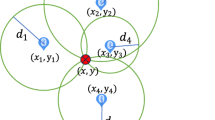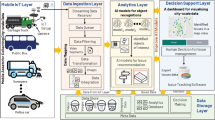Abstract
Indoor map construction by crowdsourcing has been an attractive topic. Previous works mostly focused on the indoor layout, which could be regarded as a grammar map. In this paper, we utilize CRF (conditional random field) to generate a semantic map in a mall scenario, herein predicting the function of each compartment in the grammar map. The semantic map construction consists of three steps. First, individual user’s activity patterns are featured by collecting and analyzing sensor data of smartphones. Second, the indoor layout is decided by crowdsourcing users’ uploading tracks that are obtained from the activity patterns. Third, the function of each compartment is inferred by CRF on basis of the previous two-step output. Experiments verified the prediction effectiveness and presented the prediction accuracy. This research discovers a possibility of semantic map construction without intensive labor.











Similar content being viewed by others
References
Yucel F, Bulut E (2018) Clustered Crowd GPS for Privacy Valuing Active Localization. In: IEEE Access, pp 23213–23221
Jansen K, Schäfer M, Moser D, Lenders V, Pöpper C, Schmitt J (2018) Crowd-GPS-Sec: Leveraging Crowdsourcing to Detect and Localize GPS Spoofing Attacks. In: 2018 IEEE Symposium on Security and Privacy (SP), pp 1018–1031
Alzantot M, Youssef M (2012) Crowdinside: automatic construction of indoor floorplans. In: Proceedings of the 20th international conference on advances in geographic information systems , pp 99–108
Philipp D, Baier P, Dibak C, Durr F, Rothermel K, Becker S, Peter M, Fritsch D (2014) Mapgenie: grammar-enhanced indoor map construction from crowd-sourced data. In: Proceedings of the IEEE international conference on pervasive computing and communications, pp 139–147
Ni L M, Liu Y, Lau YC, Patil AP (2003) LANDMARC: indoor location sensing using active RFID. In: Proceedings of the IEEE international conference on pervasive computing and communications, pp 407–416
Krishnan P, Krishnakumar AS, Ju WH, Mallows C, Ganu S (2004) A system for LEASE: system for location estimation assisted by stationary emitters for indoor RF wireless networks. In: Proceedings of IEEE INFOCOM, pp 1001–1011
Yin J, Yang Q, Ni L M (2008) Learning adaptive temporal radio maps for signal-strength-based location estimation. IEEE Trans Mobile Comput 7(7):869–883
Sun Z, Chen Y, Qi J, Liu J (2008) Adaptive localization through transfer learning in indoor Wi-Fi environment. In: Proceedings of the 7th international conference on machine learning, pp 331–336
Sorour S, Lostanlen Y, Valaee S (2012) Reduced-effort generation of indoor radio maps using crowdsourcing and manifold alignment. In: Proceedings of the IEEE 6th international symposium on telecommunications (IST), pp 354–358
Garcia PM, Dmytro B, Patrick R, Thomas J (2014) Pedestrian simultaneous localization and mapping in multistory buildings using inertial sensors. IEEE Trans Intell Trans Syst 15(4):1714–1727
Shen G, Chen Z, Zhang P, Moscibroda T, Zhang Y (2013) Walkie-markie: Indoor pathway mapping made easy. In: Proceedings of the 10th USENIX conference on networked systems design and implementation, pp 85–98
Luo C, Hong H, Chan MC (2014) PiLoc: A self-calibrating participatory indoor localization system. In: Proceedings of ACM/IEEE IPSN, pp 143–154
Zhou B et al (2015) ALIMC: activity landmark-based indoor mapping via crowdsourcing. IEEE Trans Intell Transp Syst 16(5):1–11
Zhou B, Li Q, Mao Q, Tu W, Zhang X (2015) Activity sequence-based indoor pedestrian localization using smartphones. IEEE Trans Human-Mach Syst 45(5):562–574
Baum LE, Petrie T (1966) Statistical interference for probabilistic functions of finite state Markov chains. Ann Math Statist 37:1559–1563
Smith R, Self M, Cheeseman P (1990) Estimating uncertain spatial relationships in robotics. In: Proceedings of autonomous robot vehicles, pp 167–193
Nieto-Granda C, III JGR, Trevor AJB, Christensen HI (2010) Semantic map partitioning in indoor environments using regional analysis. In: Proceedings of the IEEE international conference on intelligent robots and systems (IROS), pp 1451–1456
Robertson P, Garcia Puyol M, Angermann M (2011) Collaborative pedestrian mapping of buildings using inertial sensors and FootSLAM. In: Proceedings on ION GNSS, pp 1366–1377
Wu X, Yang P, Tang S, Zheng X, Xiong Y (2015) Privacy preserving RSS map generation for a crowdsensing network. IEEE Wireless Commun 22(4):42–48
Park J, Charrow B, Curtis D, Battat J, Minkov E, Hicks J, Teller S, Ledlie J (2010) Growing an organic indoor location system. In: Proceedings of the 8th international conference on mobile systems, applications, and services, pp 271–284
Bhasker ES, Brown SW, Griswold WG (2004) Employing user feedback for fast accurate low-maintenance geolocationing. In: Proceedings of the IEEE international conference on pervasive computing and communications, pp 111–120
Chintalapudi K, Padmanabha Iyer A, Padmanabhan VN (2010) Indoor localization without the pain. In: Proceedings of the 16th annual international conference on mobile computing and networking, pp 173–184
Azizyan M, Constandache I, Choudhury RR (2009) Surround-sense: mobile phone localization via ambience fingerprinting. In: Proceedings of the 15th annual international conference on mobile computing and networking, pp 261–272
Miluzzo E (2008) Sensing meets mobile social networks: the design implementation and evaluation of the CenceMe application. In: Proceedings of the 6th ACM conference on embedded network sensor systems, pp 337–350
Raychoudhury V, Shrivastav S, Sandha SS, Cao J (2015) CROWD-PAN-360: crowdsourcing based context-aware panoramic map generation for smartphone users. IEEE Trans Parallel Distrib Syst 26(8):2208–2219
Aly H, Basalamah A, Youssef M (2017) Automatic rich map semantics identification through smartphone-based crowd-sensing. IEEE Trans Mob Comput 16(10):2712–2725
Li W, Wei D, Lai Q, Li X, Yuan H (2018) Geomagnetism-aided indoor Wi-Fi radio-map construction via smartphone crowdsourcing. Sensors 18(5):1462
Gao R, Zhao M, Ye T, Ye F, Luo G (2016) Multi-story indoor floor plan reconstruction via mobile crowdsensing. IEEE Trans Mob Comput 15(6):1427–1442
Gao R, Zhou B, Ye F, Wang Y (2017) Knitter: fast, resilient single-user indoor floor plan construction. In: IEEE conference on computer communications
Ojeda L, Borenstein J (2007) Non-GPS navigation for security personnel and first responders. J Navig 60(03):391–407
Yuan X, Liu C, Zhang S, Yu S, Liu S (2014) Indoor pedestrian navigation using miniaturized low-cost MEMS inertial measurement units. In: Proceedings of IEEE/ION position, location and navigation symposium, pp 487–492
Saarinen J et al (2009) A sensor-based personal navigation system and its application for incorporating humans into a human-robot team
Chen Z, Zou H, Jiang H, Zhu Q, Soh YC, Xie L (2015) Fusion of wifi, smartphone sensors and landmarks using the Kalman filter for indoor localization. Sensors 15(1):715–732
Masiero A, Guarnieri A, Pirotti F, Vettore A (2014) A particle filter for smartphone-based indoor pedestrian navigation. Micromachines 5(4):1012–1033
Huang C, He S, Jiang Z, Li C, Wang Y, Wang X (2014) Indoor positioning system based on improved PDR and magnetic calibration using smartphone. In: 2014 IEEE 25th annual international symposium on personal, indoor, and mobile radio communication (PIMRC), pp 2099–2103
Huang C, He S, Jiang Z et al (2014) Indoor positioning system based on improved PDR and magnetic calibration using smartphone. In: IEEE 25th annual international symposium on personal, indoor, and mobile radio communication (PIMRC), pp 2099–2103
Edelsbrunner H, Kirkpatrick DG, Seidel R (1983) On the shape of a set of points in the plane. IEEE Trans Inf Theory IT-29(4):551–559
Lafferty J, McCallum A, Pereira F (2001) Conditional random fields: probabilistic models for segmenting and labelling sequence data. In: International conference on machine learning, pp 282– 289
Krahenbuhl P, Koltun V (2011) Efficient inference in fully connected CRFs with Gaussian edge potentials. In: International conference on neural information processing systems Curran associates Inc, pp 109–117
Kohli P, Ladicky L, Torr PHS (2009) Robust higher order potentials for enforcing label consistency. Int J Comput Vis 82(3):302–324
Rai A, Chintalapudi KK, Padmanabhan VN, Sen R (2012) Zee: zero-effort crowdsourcing for indoor localization. In: Proceedings of the 18th annual international conference on mobile computing and networking, pp 293–304
Yu N, Xiao C, Wu Y, Feng R (2016) A radio-map automatic construction algorithm based on crowdsourcing. Sensors 16(4):504
Acknowledgments
The authors acknowledge support from China Scholarship Council.
Author information
Authors and Affiliations
Corresponding author
Additional information
Publisher’s note
Springer Nature remains neutral with regard to jurisdictional claims in published maps and institutional affiliations.
Rights and permissions
About this article
Cite this article
Jiang, Z., Zhang, J., Liu, C. et al. FloorSense: a novel crowdsourcing map construction algorithm based on conditional random field. Pers Ubiquit Comput 24, 499–510 (2020). https://doi.org/10.1007/s00779-019-01229-w
Received:
Accepted:
Published:
Issue Date:
DOI: https://doi.org/10.1007/s00779-019-01229-w




